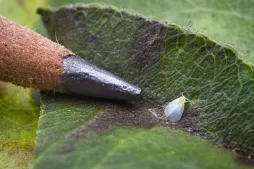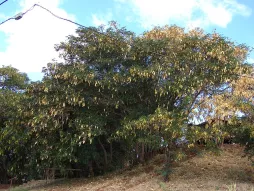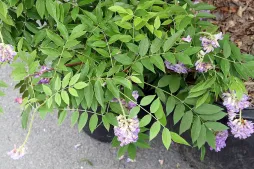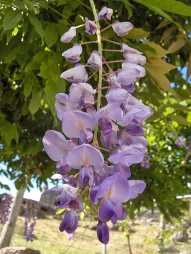Albizia julibrissin, the silk tree
Albizia julibrissin has conquered almost the entire world. This member of the Fabaceae family normally grows in Asia, from Iran to Japan. But it is now also cultivated in Europe and America, where its colorful blooms and the shade offered by its canopy are enjoyed in summer.
How to recognize the albizia julibrissin, the silk tree?
Albizia julibrissin is a spreading tree with a flat crown. It grows to between three and fifteen meters tall.
Thegray-green bark ofits trunk turns gray with age. Smooth and fine, it is dotted with white lenticels.
The light-green deciduous foliage forms a spreading crown. The alternate leaves are over 20 centimetres long. Bipinnate, they are composed of eight to fourteen pairs of leaflets. The pinnae are also highly dissected: they are made up of dozens of leaflets measuring just a few millimeters. But that's not all! Like plants in the Marantaceae family, Albizia julibirssin practices nyctinasty. The pinnules fold up at dusk or when touched.
The silk tree flowers in summer. From June onwards, panicles of fragrant flowers bloom at the tips of the twigs. At first glance, the inflorescence looks like a fluffy pompom. The threads are actually the flower stamens. The botanical variety blooms in pink and white. But it can also be completely white (Albizia julibrissin 'Albiflora' or 'Alba'), red (Albizia julibrissin 'Pompadour') or bright pink (Albizia julibrissin 'Pendula'). On the other hand, if your tree produces yellow or cream flowers, it's probably another species: siris (Albizia lebbeck).
The fruits are flattened, elongated pods ten to fifteen centimetres long. They replace the flowers in early autumn.
The melliferous flowers are a delight for insects. But the fruits are toxic to humans and domestic animals.
Our maintenance tips
Silk trees do not need watering when well established. However, in times of drought, they may need watering. You'll notice it right away:
the leaves turn yellow when the tree is thirsty.
We recommend that you plant your tree in the ground, so that it can develop properly. If you have no other option than to plant your Silk tree in a pot, transplant it to the ground when it is two or three years old, so that it can continue to grow.
the leaves turn yellow when the tree is thirsty.
We recommend that you plant your tree in the ground, so that it can develop properly. If you have no other option than to plant your Silk tree in a pot, transplant it to the ground when it is two or three years old, so that it can continue to grow.
Watering
Your Silk tree supports mains water. You can water it with reclaimed rainwater or tap water.
Before watering, make sure the surface of the soil is at least five centimetres dry.
Don't forget to drain any stagnant water in the saucer or planter.
Spray
Your the Silk Tree hates wet foliage. You must not mist the plant.
Repotting
Obtain a pierced pot larger than the root ball. Choose a terracotta model. This material optimizes drainage and limits the risk of root rot in the event of excess water.
Fill the bottom with clay balls or gravel.
Then add a layer of universal or Mediterranean potting soil. Plant your Silk tree in the center. Fill in with substrate. Do not bury the collar.
Tamp and water to remove air bubbles. You can mulch the base with a mineral material to keep the soil cool.
Fertilization
You can stimulate the growth of your plant during its growth phase, in spring and summer, with fertilizer.
Apply flowering tree fertilizer to promote growth and flowering.
Prune
Pruning is especially necessary for young trees(up to three years old). Always use clean, sharp pruning shears to promote healing and prevent the spread of disease.
Start by cutting away dead or diseased branches. Then carry out training pruning. Remove intersecting twigs and cut back upright stems. This will help the tree develop its spreading habit.
Plantation
Once the last spring frosts have passed, you can plant.
Silk trees have a very spreading habit. Plant your tree in isolation, away from your home and other shrubs, so that it can develop its crown. Choose a sunny spot, sheltered from strong winds.
Soak the root ball of your Albizia julibrissin in water. Meanwhile, dig a hole twice as wide and deeper than the root ball. Remove stones and weeds. If your soil is heavy, you can add gravel or pozzolan to the bottom to improve drainage.
Plant your plant in the center. The collar should be level with the ground. Fill the hole with garden soil. You may mix it with compost to enrich it, or gravel to lighten it.
Tamp lightly and water well to help the roots take hold.
Diseases / Threats
Information
| Family | Fabaceae - Fabaceae |
| Type | Albizia - Albizia |
| Species | Silk tree - Albizia julibrissin |
| Lifecycle | Perennial |
| Foliage | Deciduous |
| Exposures | |
| Substrats | |
| Planting method |
Open ground |
| Categories | |
| Tags |
Beginner Toxic |
| Origins |
Central Asia South Asia East Asia Southeast Asia |
| Hardiness (USDA) | 8a |
| Leaf color |
|
| Flower colors |
|
| Fruit color |
|
Discover plants from the same family
























